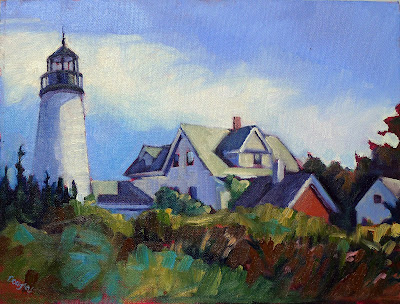The Arts Iditarod is sprinting toward a stop near you, but only if you live in Maine.
 |
| Dyce Head Light, by Carol L. Douglas |
On Jan. 8, the Maine Arts Commission will launch its 2019 Arts Iditarod. This year’s stops are:
January 8 – Portland, SPACE Gallery in Portland
January 9 –Bangor Arts Exchange
January 16 – River Arts in Damariscotta
February 5 –University of Maine at Fort Kent
January 9 –Bangor Arts Exchange
January 16 – River Arts in Damariscotta
February 5 –University of Maine at Fort Kent
The idea is to hit four of the state’s eight cultural regions each year. The meetings are aimed at arts and cultural organizations, individual artists, educators, and community policy makers. I went last year in Ellsworth and learned a lot that was pertinent to my own business.
However, I think it would be most compelling for a person contemplating a community cultural project. If that’s you, you’d be crazy to miss it.
 |
| Best Buds, by Carol L. Douglas. This carousel was a community work of art inspired by one person’s idea. |
Last fall I had the chance to visit a cultural project that is the ideal example of the impact one person’s big idea can have. The carousel at Saranac Lake, NY is a community work of art and an important part of the village’s renaissance. It was inspired by local woodworker Karen Loffler, but it took the whole community to make it a reality. Today the carousel is one of Saranac Lake’s major attractions.
The Iditarod will be your chance to figure out the nuts and bolts of bringing ideas like that into reality. Larry Rubenstein will talk about approaching potential donors and taking the fear out of asking for money. Julie Richard will give guidance on creating a strategic plan for both organizations and individuals.
| Damariscotta Main Street, by Carol L. Douglas |
There will also be a mini-Town Hall discussion in preparation for the next statewide Cultural Planning process that will begin in autumn 2019. And there will be information about Maine’s upcoming bicentennial celebrations.
Registration opens at 11:30 with programs from noon to 4 PM. You can advance register through the Maine Arts Commission website. It’s free.
“The weather for next week is looking dicey so be sure to pre-register for these so we can update you if we need to postpone,” said executive director Julie Richards. Mush!
 |
| Castine Lunch Break, by Carol L. Douglas |
One thing I’ve noticed since moving to Maine is how much the arts community is valued here. It’s surprised me how much our opinions are sought, and how we’re considered a valuable part of economic development (and not just for the purpose of gentrification).
So I suppose this is as good a place as any to mention that I was recently appointed to the Maine Arts Commission. As a new member, my first duty was being sworn in, which I did on a dark night of wet snow in the front parlor of Dr. John Lewis of Camden. He’s what they call a Dedimus Justice up here. Unique to Maine, these officials have one job: swearing in other officials.
As far as I can see, my first tasks will be to read, listen and think. Since I’m not a joiner by nature, I’m honored that outgoing governor Paul LePage thought I had something to offer.




